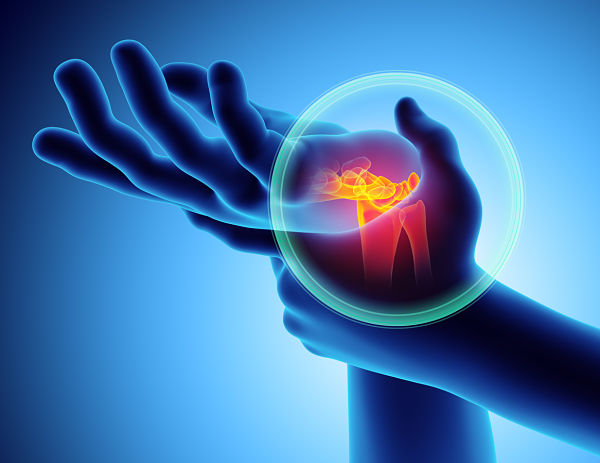The risks, symptoms, diagnosis and treatment of Carpal Tunnel Syndrome

When the median nerve in your wrist is squeezed or compressed on a continual basis it may lead to pain, decreased feeling in the fingertips and tingling and weakness in the hand and arm - a condition known as Carpal Tunnel Syndrome.
Your carpal tunnel is an inch wide passageway in the wrist which protects both the median nerve and the nine flexor tendons which enable your fingers and thumb to bend.
The squeezing or compression of your median nerve happens when
- The carpal tunnel narrows or
- The tissues surrounding it (synovium) swell
Symptoms usually begin gradually and may come and go. However, as the condition becomes worse the symptoms may be more frequent or persistent and can include:
- Feeling numbness and/or burning mainly in the thumb and your index, middle and ring fingers.
- Shock like sensations radiating to these areas
- Pain or tingling extending from the forearm up to the shoulder
- Weakness in your grip
These will be more noticeable when the wrist is bent forwards or backwards for a prolonged period of time such as using the phone, writing, grasping the steering wheel whilst driving, using a computer or reading a book
They may also feel worse at night as many people sleep with their wrist bent.
How do you get Carpal Tunnel Syndrome?
You are mostly at risk if you do activities or jobs that involve repetitive finger use. However, there are other causes of this syndrome:
- This may come about having fractured or dislocated your wrist
- In some cases, this is genetic – smaller carpal tunnels can be a family trait.
- It can occur when you are pregnant due to hormonal changes causing swelling
- It is sometimes associated with diabetes, hypothyroidism, kidney failure or inflammatory conditions like rheumatoid arthritis.
- It can also be brought on due to fluid retention – this is usually at a time of pregnancy or menopause.
- Prolonged use of vibrating tools in a workplace – especially in a cold environment may cause pressure on the median nerve
- Research has investigated any associations between prolonged use of a computer keyboard and carpal tunnel syndrome. However, studies in this area have not provided sufficient evidence of this link although there are indications that the problem may actually be caused by the computer mouse rather than the keyboard
- Carpal Tunnel Syndrome can happen as our bodies age
Only occurring in adults, women are three times more likely to develop carpal tunnel syndrome.
Reducing your risk of Carpal Tunnel Syndrome
Try to relax your grip – for example you can use soft grip adaptors on pens and lessen the force with which you hit the keys of a cash register or computer keyboard for example
Be conscious as to how you are bending your wrist. Keeping your keyboard at elbow height or slightly lower when typing may be one solution.
Try not to let your wrists get cold when doing the above tasks - fingerless gloves can help with this.
If you know you are at risk of developing the syndrome, gently stretch and bend your wrist and hands often and regularly – a few minutes each hour can make a difference
Getting a diagnosis
If you are experiencing the symptoms described above you should consult your GP. They will discuss the symptoms, look at your medical history and examine you. There are several tests which can then confirm the condition:
- Tinel’s sign – this is a tingling sensation in the fingers which occurs when your GP taps the median nerve at the wrist
- Phalen’s test – this is where you are asked to rest your elbows on the table and allow your wrist to fall forwards freely. If you have carpal tunnel syndrome your fingers will tingle and become numb within 60 seconds. The quicker this happens the more severe your condition
- They may suggest an X Ray
- They may suggest a nerve conduction study
Treatment
Depending on the severity of your condition and how well it responds to treatment, the following will be suggested
- Wearing a wrist brace
- Taking anti inflammatories
- Being given a cortisone injection
- Surgery
In addition, you can try home remedies such as putting ice on your wrist for 10-15 minutes once or twice an hour. If the pain wakes you at night gently shaking your wrist or dangling it over the side of the bed may provide some relief
I hope this has been helpful
We make every effort to ensure that all health advice on this website is accurate and up to date. However it is for information purposes and should not replace a visit to your doctor or health care professional. As the advice is general in nature rather than specific to individuals we cannot accept any liability for actions arising from its use nor can we be held responsible for the content of any pages referenced by an external link.
